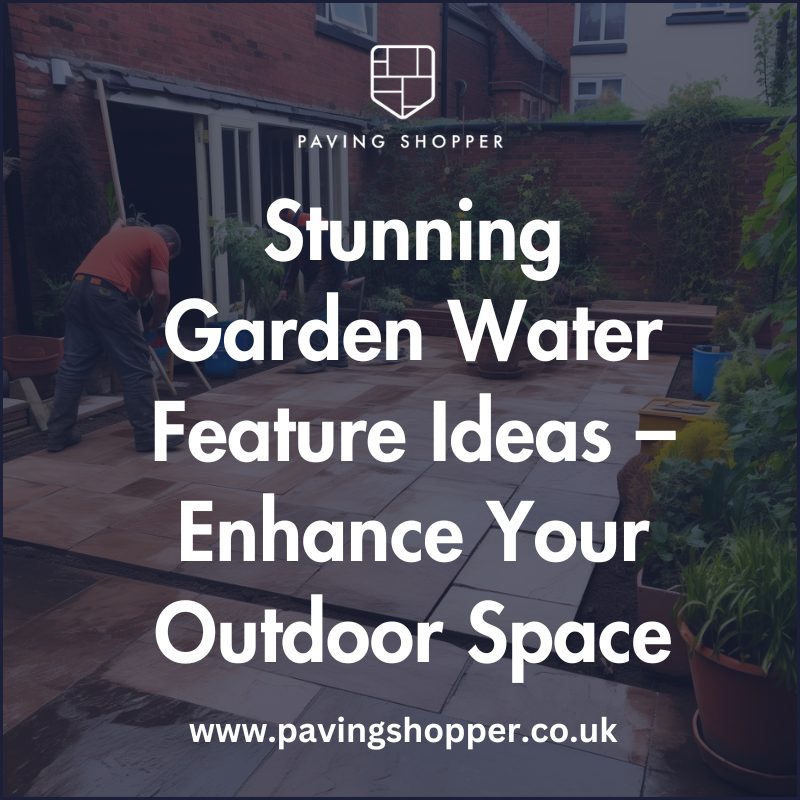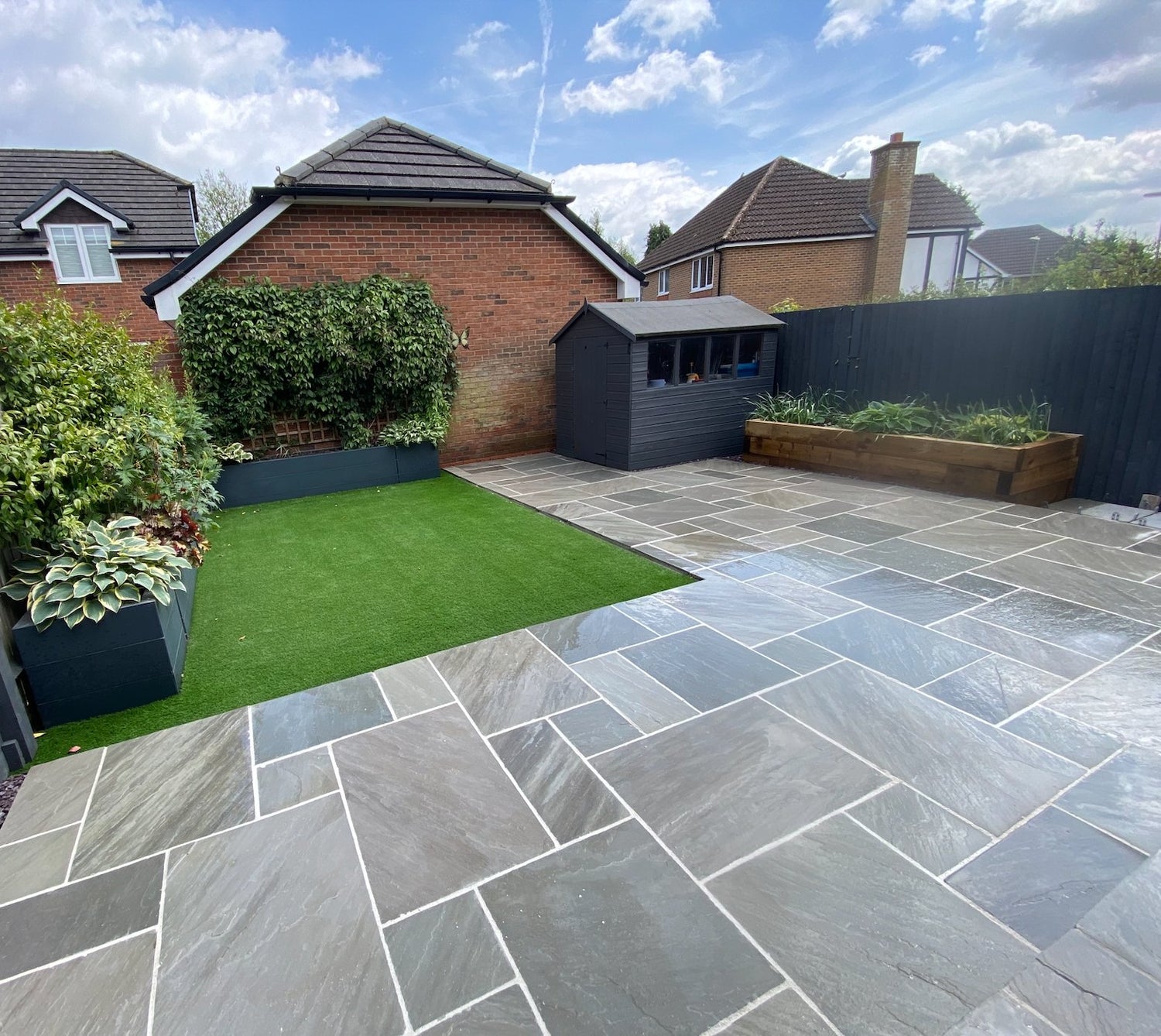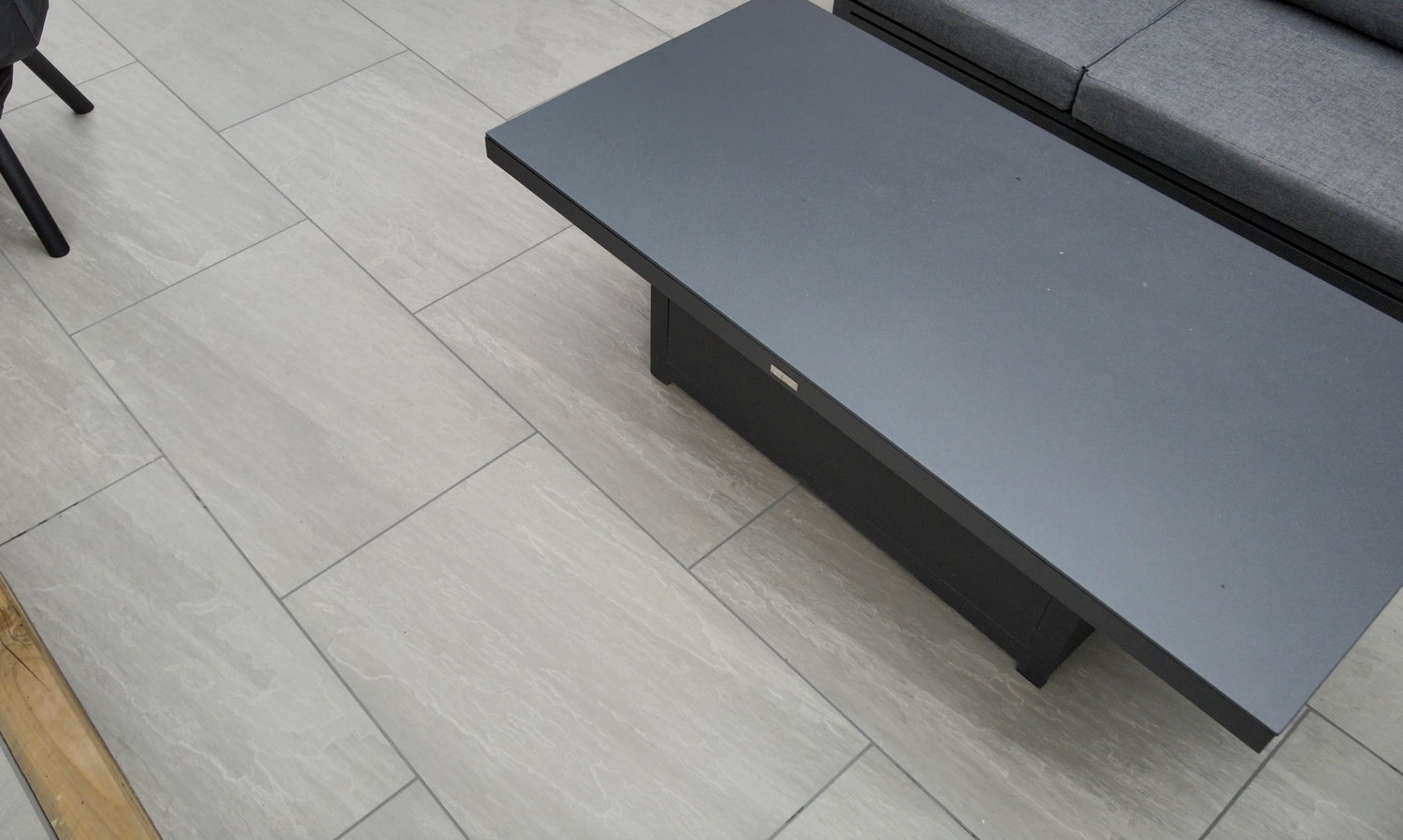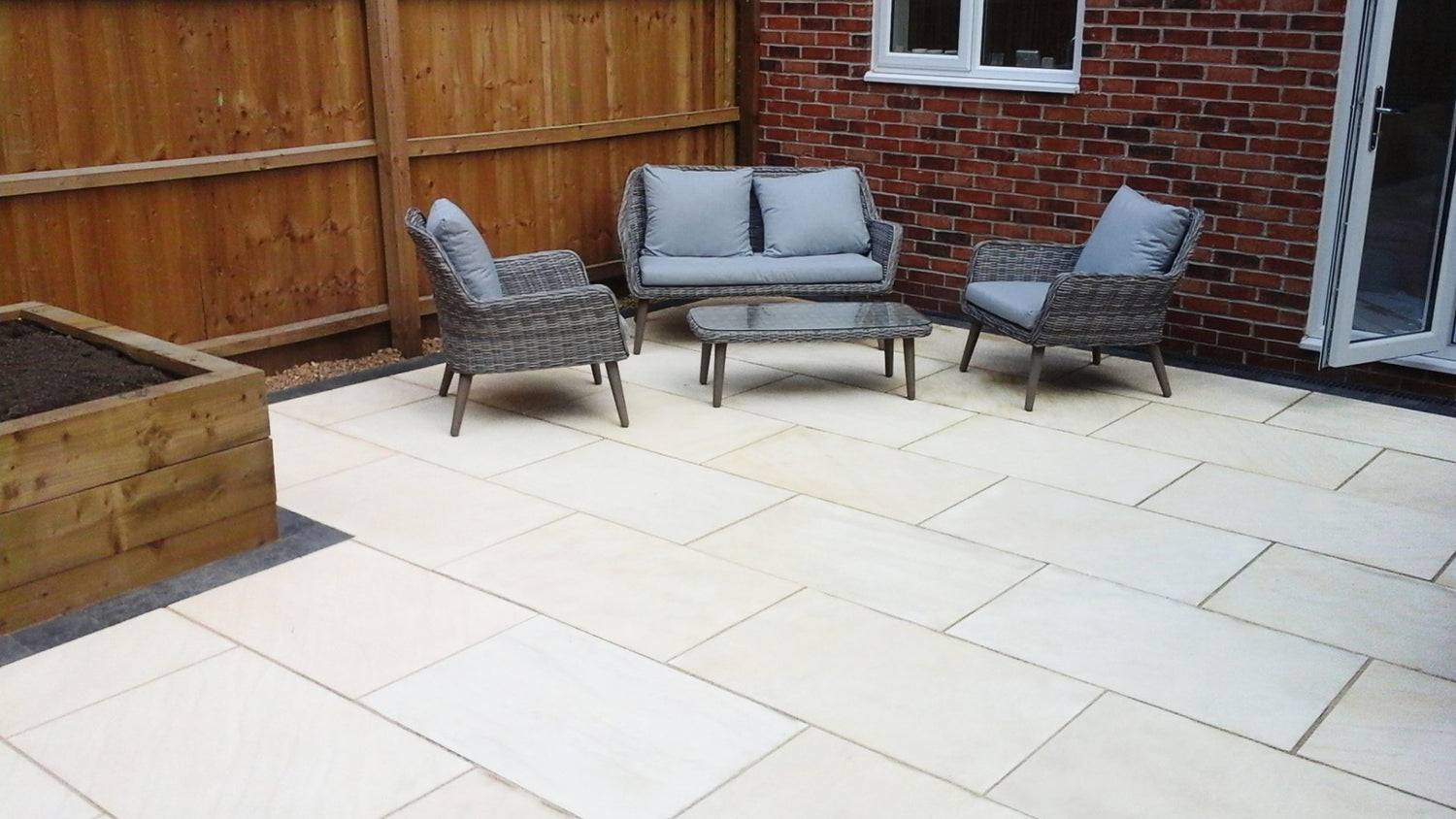
Stunning Garden Water Feature Ideas - Enhance Your Outdoor Space
Share
.jpg)
Garden water features are decorative elements that incorporate water into a garden, adding beauty and a sense of tranquillity to the outdoor space. These water features can range from simple fountains to elaborate ponds and waterfalls, and they can be a great addition to any garden. In this article, we will explore the different types of garden water features, why you should consider adding one to your garden, and some DIY ideas for creating your own water feature.
Adding a water feature to your garden can be a great idea for several reasons. Here are some of the main benefits of incorporating a water feature into your garden:
- Adds a Relaxing Ambience: The sound of running water can create a peaceful and calming atmosphere in your garden, making it the perfect place to unwind and relax.
- Attracts Wildlife: Birds, butterflies, and other wildlife are attracted to water, so adding a water feature to your garden can bring in a variety of beautiful creatures.
- Increases Property Value: A well-designed water feature can add value to your property, making it more attractive to potential buyers.
There are various types of garden water features to choose from, depending on your preferences and the available space in your garden. Some popular options include fountains, ponds, waterfalls, birdbaths, water walls, rain chains, and bubblers.
Before adding a water feature to your garden, there are a few factors to consider. These include the available space and size of the feature, your budget, and the maintenance required. It's essential to choose a water feature that fits your garden's overall design and style, and that you can afford to maintain.
When selecting a water feature for your garden, consider the following:
- Match the Style of Your Garden: A water feature should complement the overall design of your garden. For instance, a contemporary garden with porcelain slabs may look best with a sleek, modern water wall, while a more traditional Indian sandstone paved garden may suit a classic fountain.
- Consider the Sound and Movement of Water: The sound and movement of water can significantly impact the atmosphere of your garden. If you want a tranquil setting, a gentle trickle or babbling brook would be ideal, while a more dramatic water feature like a waterfall or bubbling fountain would add energy to your garden.
- Think About the Maintenance and Safety: Some water features require more maintenance than others, so consider your time and budget when choosing the right one for your garden. Also, if you have young children or pets, make sure to consider the safety of the feature you choose.
- Paving Colours - The colour of your fountain will want to contrast your paving, consider classics like neutral grey colours, beige paving, or even bolder colours like yellow . The most popular colour of 2024 looks like its going to be rainbow sandstone whilst kandla grey won out in 2023.
For those looking for budget-friendly options, there are plenty of DIY garden water feature ideas that you can easily create yourself. Here are some simple but creative ideas to get you started:
- Recirculating Fountain: Reuse an old pot or basin and turn it into a recirculating fountain by adding a pump and some rocks or water plants for decoration.
- Mini Pond in a Container: A small container, such as a barrel or large bowl, can be turned into a mini pond with the addition of some water plants and a small fountain or bubbler.
- Water Wall with a Planter: Create a water wall by attaching a plastic sheet to a wooden frame and placing a planter box on top. The water will flow down the sheet and into the planter, creating a unique and stylish feature.
- Solar-Powered Bubbler: With a solar-powered pump, a large bowl or basin, and some decorative stones, you can create a simple and eco-friendly bubbling water feature for your garden.
With these ideas and considerations in mind, you can now choose the perfect garden water feature to enhance your outdoor space and create a beautiful and serene atmosphere.
Key Points:
- Adding a water feature to your garden can create a relaxing ambiance, attract wildlife, and increase property value.
- There are various types of garden water features, including fountains, ponds, waterfalls, and more.
- Before adding a water feature, consider factors such as space, budget, and maintenance. Choose a feature that matches your garden's style and consider the sound, movement, and safety of the water.
What Are Garden Water Features?
Garden water features refer to decorative elements that incorporate water into a garden design, adding beauty and tranquility. They come in various forms, such as fountains, ponds, waterfalls, and streams. These features create a focal point, enhance the visual appeal, and provide a soothing sound. They also attract birds and other wildlife, promoting a biodiverse ecosystem.
When considering garden water features, think about the available space, the desired style, and the maintenance requirements. Some suggestions for garden water features include:
- A tiered fountain
- A koi pond
- A rock waterfall
- A simple birdbath
Why Add a Water Feature to Your Garden?
When it comes to creating a peaceful and inviting outdoor area, a water feature can make a significant impact. However, in addition to its aesthetic appeal, there are several reasons why adding a water feature to your garden can be advantageous. In this section, we will explore the different benefits of incorporating a water feature into your garden design. From creating a calm atmosphere to attracting wildlife and enhancing property value, a water feature can provide numerous advantages to your outdoor sanctuary.
1. Adds a Relaxing Ambience
Adding a water feature to your garden can create a peaceful and calm atmosphere. Here are some steps to consider when adding a water feature:
- Choose the right location: Select an area in your garden that will provide a tranquil setting and enhance the overall ambiance.
- Select the type of water feature: Decide whether you want a fountain, pond, waterfall, or any other type of water feature that aligns with your vision.
- Consider the size: Determine the appropriate size of the water feature based on the available space in your garden.
- Think about the sound and movement of water: Consider the soothing sound and visual appeal that different water features can bring.
- Maintenance and safety: Evaluate the level of maintenance required for the water feature and ensure it is safe for children and pets.
By following these steps, you can add a water feature that brings a relaxing atmosphere to your garden space.
2. Attracts Wildlife
Adding a water feature to your garden can attract wildlife and create a vibrant ecosystem. Here are some steps to attract wildlife to your garden:
- Provide a water source: Install a birdbath, shallow pond, or small fountain that offers a place for birds, butterflies, and other creatures to drink and bathe.
- Add native plants: Choose plants that provide food and shelter for wildlife, such as flowering plants for bees and butterflies, or berry-producing shrubs for birds.
- Create habitat: Incorporate elements like rocks, logs, and fallen branches to create hiding places and nesting spots for wildlife.
- Avoid pesticides: Use organic gardening practices to avoid harming beneficial insects and other wildlife.
- Offer food: Set up feeders with birdseed or nectar to attract birds and hummingbirds.
Fun fact: One example of wildlife attracted to water features is the red fox. Red foxes are skilled swimmers and are often found near bodies of water, such as ponds or streams, where they can hunt for prey and find water to drink.
3. Increases Property Value
Adding a water feature to your garden can significantly increase the value of your property. Here are some steps to consider:
- Choose a water feature that complements the overall design and style of your garden.
- Consider the size and scale of the water feature to ensure it fits seamlessly into the space.
- Think about the maintenance requirements of the water feature and whether you have the time and resources to keep it in good condition.
- Ensure the water feature is safe and doesn't pose any risks, especially if you have children or pets.
In a study conducted by the National Association of Realtors, it was found that homes with water features, such as ponds or fountains, sold for an average of 12% more than homes without. This shows that adding a water feature to your garden can not only enhance its beauty and tranquility but also have a positive impact on the value of your property.
Types of Garden Water Features
A water feature can bring a sense of peace and beauty to any garden. There are different kinds of garden water features, each with their own special qualities and advantages. In this section, we will discuss the different types of garden water features, such as fountains, ponds, waterfalls, birdbaths, water walls, rain chains, and bubblers. Whether you desire a calm babbling brook or an eye-catching centerpiece, there is a water feature that will complement your garden perfectly.
1. Fountains
Adding a fountain to your garden can enhance its beauty and create a peaceful atmosphere. Here are some steps to consider when adding a fountain:
- Choose the right location: Find a spot that will complement your garden and provide a focal point.
- Determine the size: Consider the available space and select a fountain that fits well.
- Select a style: There are various styles of fountains to choose from, such as tiered, wall-mounted, or freestanding.
- Decide on the material: Fountains can be made of stone, concrete, metal, or resin. Choose one that suits your garden's aesthetic and climate.
- Consider the water source: Ensure easy access to a water supply for the fountain to function properly.
- Install the fountain: Follow the manufacturer's instructions or hire a professional to install the fountain securely.
- Maintain and clean: Regularly clean the fountain to keep it in good condition and prevent algae growth. Check for any necessary repairs or adjustments.
2. Ponds
Ponds are a popular water feature for gardens, creating a peaceful and natural atmosphere. If you are thinking of adding a pond to your garden, here are the steps to follow:
- Plan the location and size of the pond, making sure it fits well within your garden space.
- Consider the depth and shape of the pond, keeping in mind the type of aquatic plants and fish you want to have.
- Excavate the area for the pond, removing any rocks, roots, or debris.
- Install a pond liner or preformed shell to ensure that the water remains contained.
- Add a layer of sand or underlayment to protect the liner.
- Fill the pond with water, making sure it is level and balanced.
- Add aquatic plants, such as water lilies or floating plants, to enhance the natural beauty of the pond.
- Introduce fish if desired, making sure they are suitable for the size and conditions of the pond.
- Install a filtration system to maintain water quality and prevent algae growth.
- Regularly monitor and maintain the pond, including cleaning debris, trimming plants, and checking water parameters.
By following these steps, you can create a stunning and peaceful pond in your garden.
3. Waterfalls
Waterfalls are a popular garden water feature that can enhance the beauty and tranquility of your outdoor space. Here are some steps to consider when incorporating a waterfall into your garden:
- Choose the location: Select a spot that allows the waterfall to be a focal point and is easily visible from different angles.
- Determine the size and scale: Consider the available space and the overall design of your garden to determine the appropriate size and scale for the waterfall.
- Create a water source: Ensure you have a water source, such as a pond or reservoir, to supply the waterfall with a continuous flow of water.
- Design the structure: Plan the shape, height, and cascading effect of the waterfall to create a visually appealing and natural-looking feature.
- Add rocks and plants: Incorporate rocks of different sizes and shapes to create a realistic waterfall effect. Plant water-loving plants around the waterfall to enhance its natural appeal.
- Install a pump and filtration system: To maintain the waterfall's functionality and cleanliness, install a pump to circulate the water and a filtration system to remove debris.
- Consider lighting: Install outdoor lighting to highlight the waterfall at night, creating a magical ambiance in your garden.
Waterfalls can add a touch of serenity and beauty to any garden. Consider these steps to create your own stunning waterfall feature and enjoy the soothing sound of flowing water in your outdoor oasis.
4. Birdbaths
Adding a birdbath to your garden can be a beneficial and enjoyable addition for both you and the birds. Here are some steps to consider when incorporating a birdbath into your garden:
- Location: Choose a spot that is easily visible to you and the birds, preferably near some plants or trees for shade and protection.
- Size and Depth: Ensure the birdbath is shallow, with a maximum depth of about 2 inches, so birds can comfortably bathe and drink.
- Material: Select a birdbath made of a durable material like ceramic, stone, or plastic, which is easy to clean and maintain.
- Water Source: Connect the birdbath to a water source, like a hose or fountain, to provide a continuous supply of fresh water for the birds.
- Maintenance: Clean the birdbath regularly to prevent the growth of algae or bacteria. Scrub it with a brush and replace the water every few days.
- Attractiveness: Consider adding decorative elements, like rocks or plants, around the birdbath to make it more visually appealing for both you and the birds.
5. Water Walls
Water walls are a popular type of garden water feature that can add beauty and tranquility to any outdoor space. Here are the key steps to consider when incorporating water walls into your garden:
- Determine the location: Choose a suitable spot in your garden that provides a focal point and complements the overall design.
- Select the style: Decide on the style and material of the water wall that aligns with your garden's aesthetic. Options include natural stone, glass, or metal.
- Consider water source and drainage: Ensure there is a nearby water source for the water wall to function properly. Additionally, plan for proper drainage to prevent water accumulation.
- Install a pump and reservoir: Set up a pump and reservoir system to circulate the water from the reservoir to the top of the water wall, creating a continuous flow.
- Add lighting and plants: Enhance the visual appeal of the water wall by incorporating lighting elements and selecting plants that complement the design.
Remember to consult with a professional or research local regulations before installing a water wall to ensure compliance and safety.
6. Rain Chains
Rain chains are a popular and visually appealing alternative to traditional downspouts for guiding rainwater in gardens. To install a rain chain, follow these steps:
- Choose a suitable location for the rain chain, ensuring it will catch rainwater effectively.
- Remove the downspout from the gutter where the rain chain will be installed.
- Attach a gutter adaptor or rain chain basin to the gutter outlet.
- Hang the rain chain from the adaptor or basin, ensuring it reaches the ground or a collection container.
- Adjust the length of the rain chain if necessary.
- Secure the rain chain to the ground or container to prevent it from swinging in strong winds.
Consider adding decorative elements to the rain chain, such as bells or cups, to enhance its aesthetic appeal. Remember to regularly clean and maintain the rain chain to ensure proper functionality.
7. Bubblers
Bubblers are a popular type of garden water feature that adds charm and tranquility to outdoor spaces. Here are the steps to consider when incorporating bubblers into your garden:
- Choose the right location: Select an area with access to electricity and a sturdy surface for installation.
- Determine the size: Consider the available space and the desired visual impact of the bubbler.
- Select the design: Bubblers come in various styles, from sleek and modern to more natural and rustic.
- Install the bubbler: Follow the manufacturer's instructions for proper installation, including connecting the water supply and ensuring proper drainage.
- Add decorative elements: Enhance the bubbler with rocks, plants, or other decorative elements that complement your garden's aesthetic.
- Maintain the bubbler: Regularly clean and maintain the bubbler to ensure its proper functioning and longevity.
Factors to Consider Before Adding a Water Feature to Your Garden

Photo Credits: Www.Pavingshopper.Co.Uk by Juan Adams
Adding a water feature to your garden can enhance its beauty and bring a sense of tranquility. However, before starting any garden renovation project, it is important to carefully consider various factors. In this section, we will discuss the key elements to keep in mind before adding a water feature to your garden. From the available space and size to your budget and maintenance requirements, each factor plays a crucial role in determining the success of your water feature.
1. Space and Size
When adding a water feature to your garden, considering the space and size is crucial. Follow these steps to ensure the right fit:
- Measure the available space accurately.
- Consider the proportions of your garden and choose a water feature that complements it.
- Think about the scale of the water feature in relation to your plants and other elements.
- Take into account any restrictions or regulations in your area regarding the size of water features.
One homeowner wanted to add a water feature to their small urban garden but realized they had limited space. They opted for a compact wall-mounted fountain that perfectly fit their garden's size, adding a touch of elegance and tranquility.
2. Budget
Considering your budget is an essential factor when adding a water feature to your garden. Here are some steps to help you stay within your budget:
- Determine your budget: Decide how much you are willing to spend on a water feature.
- Research costs: Look into the different types of water features available and their associated costs.
- Compare prices: Compare prices from different suppliers or retailers to find the best deal.
- Consider DIY options: Explore do-it-yourself options that can save money on labour costs.
- Set priorities: Decide which features are most important to you and allocate your budget accordingly.
- Factor in maintenance costs: Remember to consider ongoing maintenance costs when budgeting for a water feature.
3. Maintenance
Maintaining a garden water feature is essential to keep it functioning properly and looking its best. Follow these steps to ensure the proper maintenance of your water feature:
- Regular cleaning: Remove debris, algae, and leaves from the water feature to prevent clogging and maintain water quality.
- Check the pump: Regularly inspect the pump to ensure it is working correctly and clean or replace it if necessary.
- Water quality: Test the water regularly and adjust the pH levels as needed. Add necessary treatments like algae control or water clarifiers.
- Inspect for leaks: Check for any leaks or cracks in the water feature and repair them promptly to prevent further damage.
- Winter maintenance: During colder months, drain the water feature and store any removable parts to protect them from freezing temperatures.
History shows that the maintenance of water features was crucial in ancient civilizations as well. The Hanging Gardens of Babylon, one of the Seven Wonders of the Ancient World, required diligent maintenance to ensure the flow of water to the cascading gardens. Regular cleaning and upkeep were vital to maintain the beauty and functionality of these magnificent water features.
How to Choose the Right Water Feature for Your Garden?

Photo Credits: Www.Pavingshopper.Co.Uk by Zachary Hall
When it comes to enhancing your garden, a water feature can add a touch of tranquility and beauty. But with so many options available, how do you choose the right one for your garden? In this section, we'll discuss three key factors to consider when selecting a water feature: matching the style of your garden, considering the sound and movement of water, and thinking about maintenance and safety. By keeping these aspects in mind, you can find the perfect water feature to complement your outdoor space.
1. Match the Style of Your Garden
When choosing a water feature for your garden, it's important to consider matching the style of your garden. Here are some steps to help you accomplish this:
- Assess your garden's overall style, whether it's formal, contemporary, rustic, or tropical.
- Research different types of water features that align with your garden's style. For example, a classic fountain may suit a formal garden, while a natural pond complements a rustic setting.
- Consider the materials and design elements of the water feature. Choose materials and finishes that harmonize with the existing features in your garden.
- Take into account the scale and proportion of the water feature. Ensure it complements the size and layout of your garden without overpowering or appearing too small.
- Be mindful of the colors and textures of the water feature. Opt for colors that blend seamlessly with the surrounding plants and hardscape elements.
Garden water features have been used for centuries to enhance the beauty and tranquility of outdoor spaces. Ancient civilizations, such as the Romans and Egyptians, incorporated water features into their gardens as symbols of prosperity and serenity. Today, matching the style of your garden with a water feature continues to be a popular choice for creating a harmonious and visually appealing outdoor oasis.
2. Consider the Sound and Movement of Water
When adding a water feature to your garden, it is important to consider the sound and movement of water in order to create a peaceful and visually appealing space. Here are some steps to help you achieve this:
- Choose a water feature that produces a soothing sound, such as a gentle trickle or soft babbling stream.
- Incorporate movement by selecting a feature that includes cascading waterfalls, flowing streams, or a rotating fountain.
- Strategically position the water feature to maximize the sound and movement. Placing it near seating areas or pathways will enhance the experience.
- Consider the size of the water feature. Larger features tend to have more significant sound and movement, while smaller ones offer a more subtle effect.
- Regularly maintain the water feature to ensure proper functioning, as any issues can affect the sound and movement.
By considering the sound and movement of water in your garden, you can create a peaceful and captivating atmosphere that will enhance your outdoor space.
3. Think About the Maintenance and Safety
When adding a water feature to your garden, it is important to consider maintenance and safety. Follow these steps to ensure that your water feature is well-maintained and safe:
- Regular cleaning: Clean the water feature regularly to prevent the growth of algae and accumulation of debris.
- Proper filtration: Install a reliable filtration system to keep the water clean and clear.
- Secure edges: Make sure that the edges of the water feature are secure to prevent accidents or falls.
- Childproofing: If you have children, take necessary precautions to childproof the water feature, such as installing safety covers or fences.
- Electrical safety: If your water feature requires electricity, hire a professional to handle the electrical connections to avoid any hazards.
There is a real-life story that highlights the importance of maintenance and safety. A family installed a beautiful pond in their garden but due to negligence in maintaining the pond and securing its edges, their toddler accidentally fell into the pond and had to be rescued. This incident serves as a reminder to always prioritize maintenance and safety when adding water features to your garden.
DIY Garden Water Feature Ideas

Photo Credits: Www.Pavingshopper.Co.Uk by Ethan Allen
Are you looking to add a touch of tranquility to your garden? Look no further than these DIY garden water feature ideas. Each of these unique projects can be easily created at home and will bring the soothing sound of flowing water to your outdoor space. From a recirculating fountain to a mini pond in a container, and even a water wall with a planter, these innovative ideas will elevate your garden to a whole new level. So, let's dive into the details of these DIY garden water features and get ready to turn your backyard into a peaceful oasis.
1. Recirculating Fountain
A recirculating fountain is a popular garden water feature that adds beauty and tranquility to outdoor spaces. Here is a list of steps to create a recirculating fountain for your garden:
- Choose a suitable location for your fountain, considering the size of the space and visibility.
- Select a fountain design that complements the style of your garden, such as a classic tiered fountain or a modern abstract fountain.
- Determine the water source and connect the fountain to a reliable water supply.
- Install a recirculating pump to continuously circulate the water and create a soothing sound.
- Add decorative elements like rocks, pebbles, or plants to enhance the aesthetic appeal of the fountain.
- Regularly clean and maintain the fountain to keep it in optimal condition.
By following these steps, you can create a beautiful and functional recirculating fountain that will enhance your garden's ambiance.
2. Mini Pond in a Container
Creating a mini pond in a container can be a great way to add a water feature to your garden, even if you have limited space. Here are the steps to create your own mini pond:
- Choose a container: Select a suitable container like a large bowl or barrel.
- Add water: Fill the container with water, leaving some space at the top.
- Add plants: Place aquatic plants like water lilies or floating plants in the water.
- Add decorations: Enhance the visual appeal by adding rocks, stones, or a small fountain.
- Provide shade: Place the container in a partially shaded area to prevent excessive sunlight.
- Maintain water quality: Use a small pump or filter to keep the water clean and prevent stagnation.
- Enjoy your mini pond: Sit back, relax, and enjoy the serene beauty of your mini pond in a container!
Fun fact: Mini ponds in containers can attract small wildlife like frogs and dragonflies, adding a touch of nature to your garden.
3. Water Wall with a Planter
A water wall with a planter is a unique and visually appealing garden water feature that combines flowing water with a space for plants. Creating a water wall with a planter involves several steps:
- Select a suitable location for your water wall with a planter.
- Choose the desired size and shape of the water wall structure.
- Install a water pump and tubing system to circulate the water.
- Attach a planter box or containers to the water wall structure.
- Add appropriate soil and select plants that can thrive in a water-rich environment.
- Connect the water supply to the pump and test the flow of water.
- Regularly maintain and clean the water feature and plants.
Pro-tip: Consider incorporating water-loving plants, such as ferns or water lilies, in the planter to enhance the beauty and natural feel of your water wall.
Related Posts
-

UK Garden Statistics and Trends 2024
UK Garden Statistics and Trends 2024 General UK Garden Statistics The vast majority of UK households have access to ...
-

Can I lay Paving on Soil or Mud?
Technically, yes – you can lay paving stones or slabs directly onto exposed topsoil however, laying a sub-base will e...
-

How Much Does a New Patio Cost?
A new patio in the UK typically costs between £80-£150 per square meter. For a 40-50 sqm patio, expect to pay £2,000-...
-

What Different Sizes Do Paving Slabs Come In?
When planning a patio or outdoor paving project, one of the key decisions is choosing the right size paving slabs. ...
-

Can You Pressure Wash Indian Sandstone?
Indian sandstone is a popular choice for outdoor paving due to its durability and attractive appearance. However, li...
-

Is Sandstone Paving Permeable? Is it porous?
Sandstone's porous nature enables it to absorb rainfall, qualifying it as a permeable paving variety. However, seali...
-

Where Does Natural Sandstone Paving Come From?
Sandstone begins deep underground, formed over eras as minerals and sediments fused under pressure. Powerful forces ...
-

5 Paving Ideas for Small Gardens: Maximise Your Outdoor Space
Front of House When considering paving ideas for the front of your house, it's crucial to select ones that complem...
-

9 Paving Ideas for Front of House: Enhancing Curb Appeal with Style
The facade of a house plays a pivotal role in defining its character and curb appeal, and the choice of paving can s...
-

9 Summer Garden Paving Ideas UK
Summer gardens offer a vibrant canvas for homeowners to express their style while enhancing outdoor living spaces. G...
-

8 Garden Paving Ideas for 2024
It's time to refresh your garden's look for 2024 and an easy way to do that is with some new paving. With so many opt...
-

How to remove moss from patio paving
Moss growth is a common issue for patio paving, especially in damp, shaded areas. While moss may seem harmless, it ca...
-

How much does sandstone paving cost?
When choosing new garden pavers, sandstone offers homeowners an enticing middle-ground - more durable than basic conc...
-

Why Do Paving Slabs Crack And How To Repair Them
Seeing cracks appear on your patio or driveway can be disheartening after investing time and money into installing be...
-

How to lay paving in winter (Tips & Tricks)
How Cold Temperatures Impact Paving Projects The primary concern when working in cold weather is ensuring proper curi...
-

Sub Bases For Patios
Building the Perfect Patio Base: A Comprehensive Guide When planning an outdoor living space, understanding proper ba...
-

Pros and Cons of Porcelain Paving
Are you considering adding porcelain paving to your outdoor space? It's important to weigh the pros and cons before ...
-

Understanding Paving Slip Ratings: A Comprehensive Guide
A paving slip rating, also known as a slip resistance or anti-slip rating, is a measure of how slippery a surface...
-

How to Stop Weeds in Block Paving: Expert Tips andTricks
Weeds growing between the blocks of your paving can be an unsightly and frustrating problem. Not only do they make y...
-

How to clean paving without a pressure washer
A patio cleaner is a cleaning solution designed specifically for removing dirt, grime, and stains from outdoor patio...
-

How to Grout Paving Slabs – Expert Tips and Techniques
Pointing paving slabs is an important step in the process of installing them. Grout is a mixture of cement, water...
-

Block Paving Guide | What Does it Cost? | How Much Per m2?
Block paving is a versatile and durable option for creating driveways, patios, and paths. This method involves using...
-

Porcelain VS Ceramic Paving
Porcelain paving is non-porous and more durable than ceramic paving, which is more porous and prone to stains and wea...
-

Sandstone V Porcelain Paving - (Style Comparison and Distinctions)
When choosing materials for your patio or driveway, two of the most popular options are sandstone paving slabs and p...
-

Understanding Gradients and Falls for Paving and Drainage (2024)
When it comes to paving and drainage projects, understanding the correct gradients and falls is essential for ensuri...
-

Indian Sandstone Paving Colours for A Patio - A Comprehensive Guide
Indian sandstone is one of the most popular paving materials, celebrated for its natural beauty and the variety of co...
-

Jointing and Pointing For Paving (Sand & Cement Mix)
Patio pointing is important for both looks and durability. It protects the layers under your paving, stops weeds, and...
-

How to Lay Paving on Sand and Cement: Expert Advice and Tips
Paving on Sand and Cement: A Comprehensive Guide When it comes to enhancing your outdoor space, paving is a popular ...
-

Pros and Cons of Sandstone Paving
Pros & Cons of Indian Sandstone Paving Indian sandstone paving is a natural and durable option that adds both bea...
-
Does Patio Paving Need Edging? A Comprehensive Guide
In this article, we'll explore the importance of patio edging, the different types of edging materials available, and...
-

Pet Friendly Paving - What is the best paving for a dog-friendly garden?
Creating a dog-friendly garden requires choosing the right paving materials to ensure your furry friends can enjoy t...
-

Patio Paving Laying Patterns Guide
Paving patterns can transform an ordinary outdoor space into a stunning and eye-catching area that complements your ...
-

Patio Kits vs Single Size Paving Slabs: Which To Choose?
When designing a patio or outdoor space, one crucial decision is whether to use a patio kit (also known as patio pack...
-

Are paving slabs suitable for driveways?
This is a question many homeowners ask when it comes to choosing the right type of driveway surface for their home. T...
-

How much paving do you need to cover your outdoor space?
Planning an outdoor paving project is exciting, but it’s crucial to accurately estimate the amount of paving needed b...
-

What is the Best Paving for Patios?
When it comes to choosing the best paving for patios, there are a variety of factors to consider, such as durability,...
-

Sandstone v Limestone v Porcelain: The Pros and Cons of Different Garden Paving Materials
Transforming your outdoor space involves choosing the right paving material, and porcelain and sandstone are two of t...
-

Are Paving Slabs Cheaper Than Decking?
Transforming your backyard into the ultimate outdoor oasis can be challenging when choosing between paving slabs or d...
-

How to lay a patio - An expert guide to laying paving slabs and patterns
There are a few things to consider before laying a patio, such as the type of paving stones and the laying pattern. Y...
-

How to cut Sandstone Paving?
When it comes to prepping your garden for a new patio, you may consider different designs that require your paving to...












































